Ever tried gluing stained wood and faced a hiccup? Let’s dive into the art and science of making that bond last! Curious? Read on!
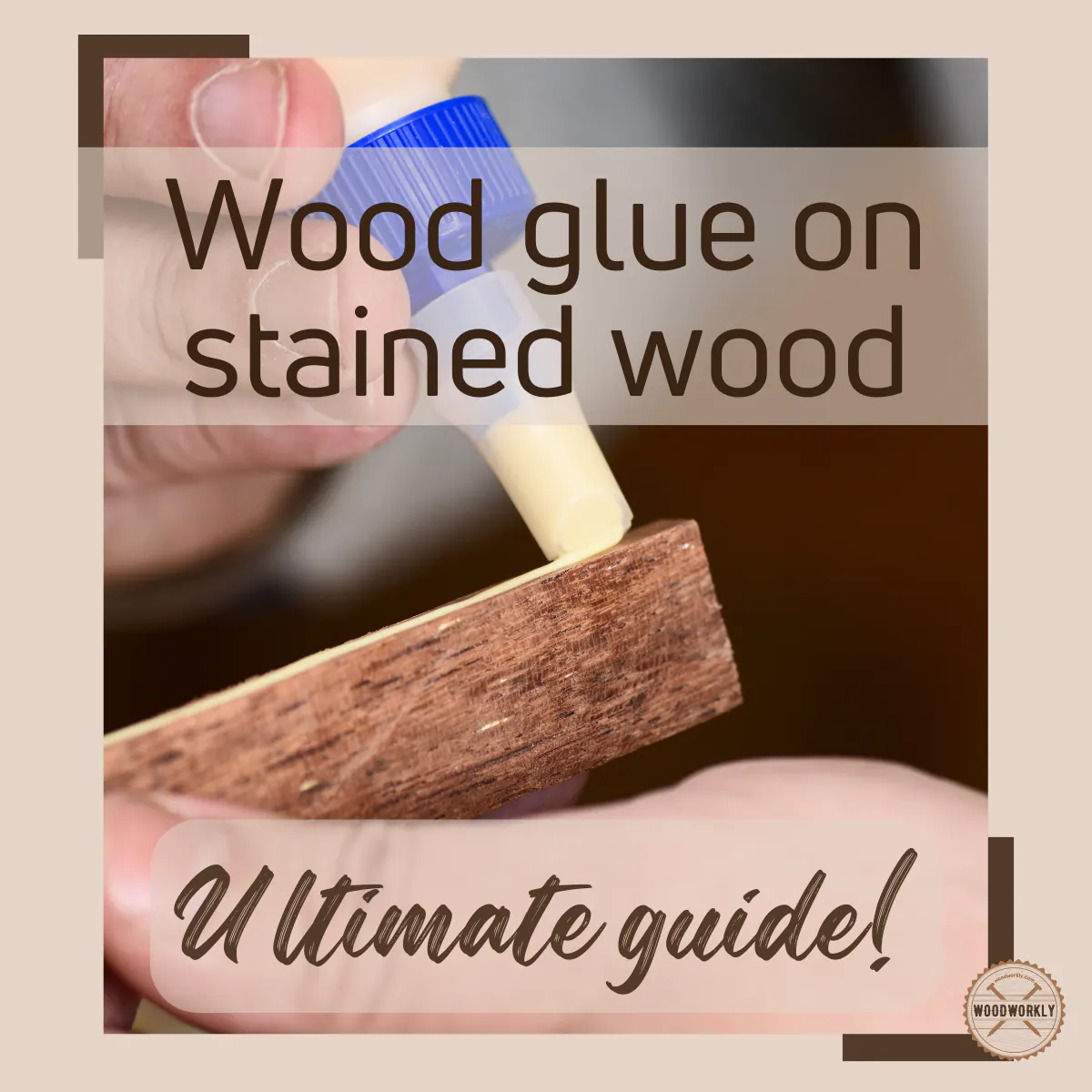
As a seasoned woodworker, I remember my early days being riddled with questions, one of which was: “How to glue stained wood?”
Well, I learned the hard way when an attempt to join two stained pieces resulted in a weak bond.
It’s a common misconception and a pitfall many of us fall into.
Dive into this article as we explore expert insights on how to successfully glue stained woods, ensuring a strong and lasting connection.
So, let’s find out, Does Wood Glue Work on Stained Wood?
Yes, wood glue can work on stained wood, but its effectiveness varies based on the type of stain and glue used. For optimal adhesion on stained surfaces, it’s recommended to lightly sand the area before applying glue. Always test a small section first to ensure a strong bond.
That’s just a quick snapshot of the question.

Even though regular wood glue works well on bare wood, there are specialized wood glues available in the market that also work perfectly on stained wood.
So, in this article, I dig into various topics like, how to apply wood glue after staining, what glues are best for stained wood and how they work, does wood glue work on finished wood,
Plus, I’ll answer frequently asked questions as well.
Let’s dig in!
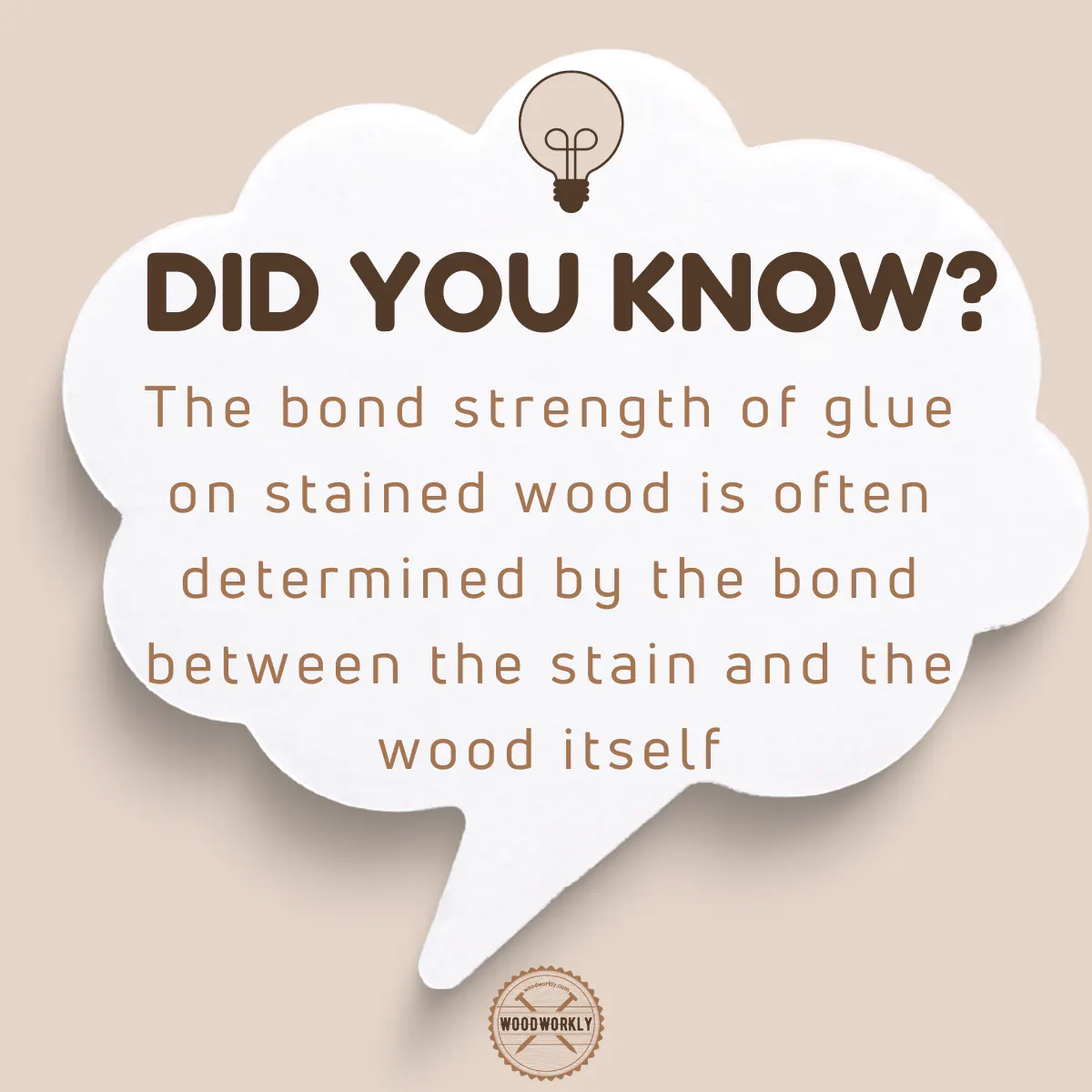
This post contains affiliate links. As an Amazon Associate, I earn from qualifying purchases. I endorse only products I truly recommend. If you make a purchase using one of these links, I may receive compensation at no extra cost to you. For more information, see my disclosure policies.
Can You Use Wood Glue After Staining?
Yes, you can use wood glue after staining. But it’ll be a quite difficult task than applying wood glue on bare wood because of several reasons.
After the wood staining is done, the pores of the wood are covered with a stain. When we apply wood glue on bare wood, it penetrates through those pores to build up the strong joint we want.
But on this occasion, due to the covering of pores, wood glue cannot penetrate and doesn’t give the strong joint we wish.
The general rule of thumb is to apply the glue before the staining. Because bare wood can easily hold wood pieces together than stained wood.
But there are some occasions you need to consider applying wood glue after the staining is done.
For example, if you’re making a cupboard, staining the undersides is difficult after the gluing is done. In that case, the best method is to do the staining first and then go for the gluing part.
So, you need to have a clear understanding of how to apply wood glue after staining the wood.
Because of the difficulty in making the strong joint, even though your wood is strong enough it cannot bear much load/force especially in joint positions. Because it reduces the holding strength.
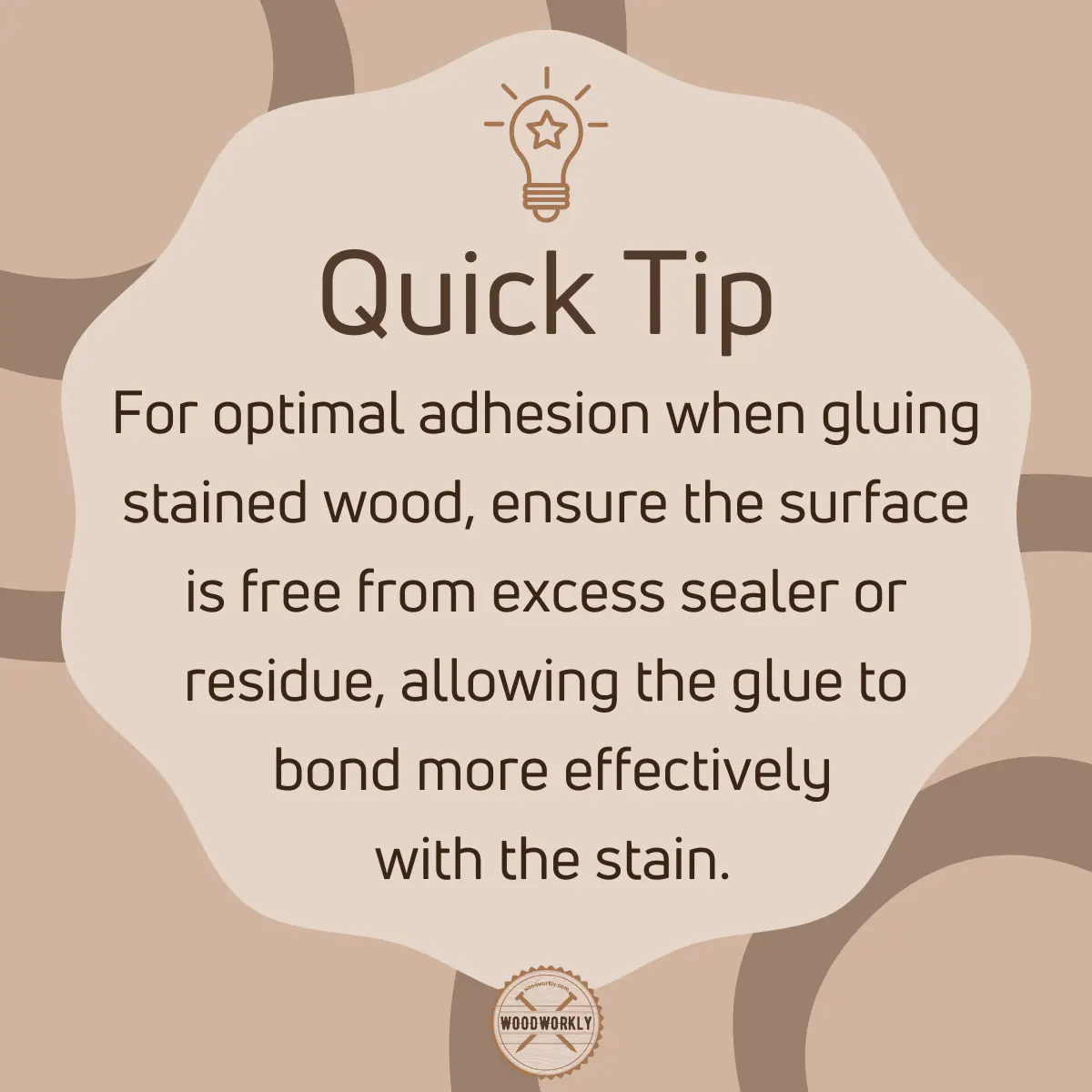
Even though general wood glue doesn’t go well with stained wood, there are some other types of wood glue that are specialized for stained wood and can build up the strong joint as we want.
So, let’s talk about them.
What Glue Works on Stained Wood?
Many of the wood glue that is available on the market is for bare wood.
So, you need to have a proper understating of wood glue before applying them to your stained wood surface to get the strong joint you wish.
According to my years of experience in woodworking, here I have listed some of the best wood glues that work perfectly on stained wood surfaces.
They are,
- Titebond Polyurethane glue
- Gorilla wood glue
- Elmer’s wood glue MAX
Those wood glues work well on finished wood.
So, let’s discuss the characteristics of each wood glue with its pros and cons.
Titebond Polyurethane Glue for Stained Wood
Titebond Polyurethane glue is the best wood glue for stained wood. It gives epoxy-like strength to build strong joints and basically can hold any stained wood type together.
Most importantly Titebond polyurethane glue is 100% waterproof and solvent-free.
Here I have listed the guidelines you should follow when applying Titebond polyurethane glue over stained wood.
- Keep the application temperature around 500F (100C)
- The time required to complete the assembly is around 25-30 minutes.
- The clamping pressure can determine by yourself what is required to clamp the wood together.
Here I have listed some pros and cons of using Titebond polyurethane glue over stained wood surfaces.
| Pros | Cons |
| Build strong joint | Need moisture for curing |
| Waterproof | Expands after application |
| Solvent-free |
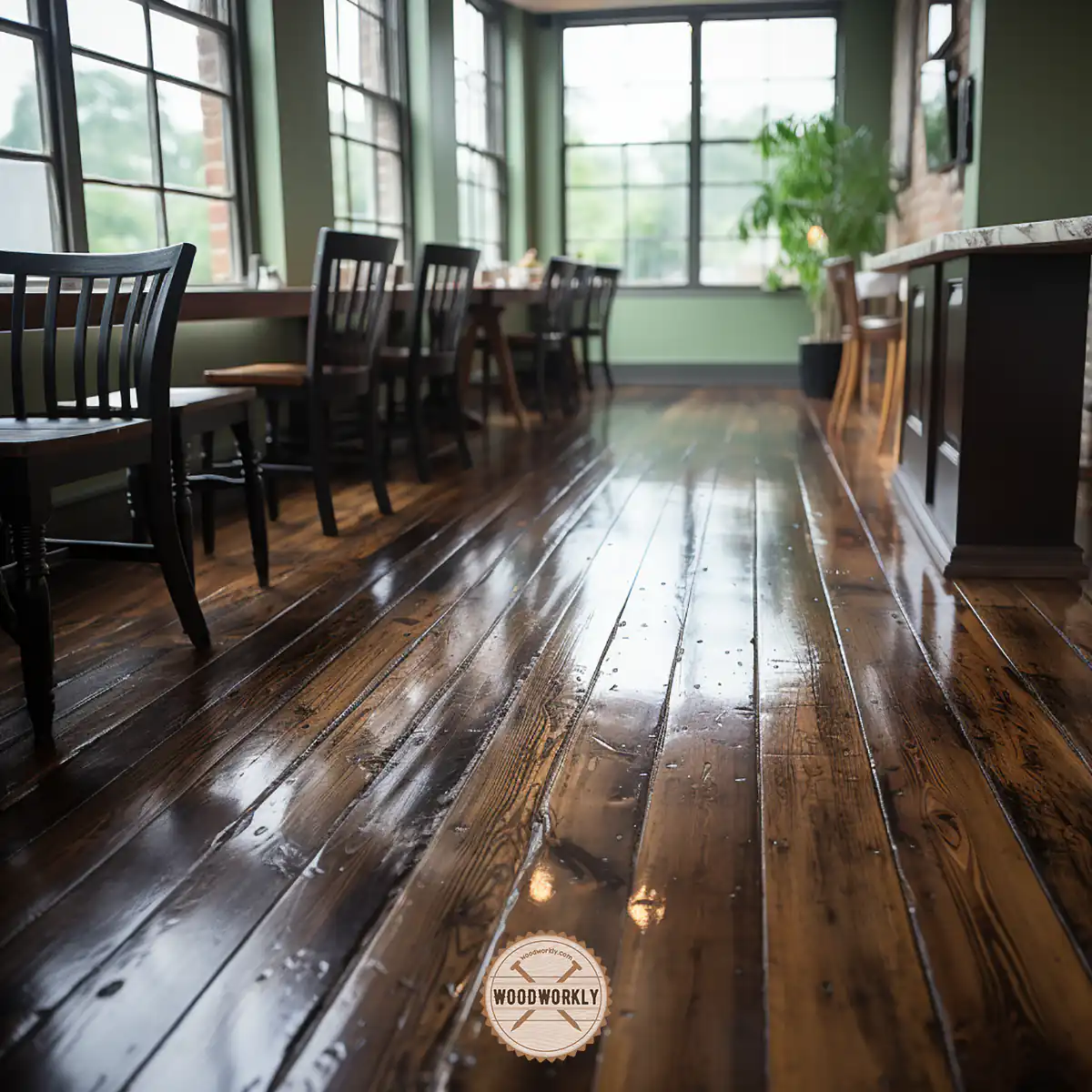
Gorilla Wood Glue for Stained Wood
Gorilla wood glue is a PVA glue that is able to create a strong joint over stained wood surfaces. I have used Gorilla wood glue for many woodworks and gained the best results out of it.
It has good weather resistance and is great for both indoor and outdoor applications.
Here I have listed some pros and cons of using Gorilla wood glue over stained wood.
| Pros | Cons |
| Build strong joint | Clamping is required |
| Weather resistance | Curing time is high |
| Can use for both Indoors and Outdoors | |
| Give natural color after drying | |
| Sanding is possible | |
| Doesn’t change the dimensions after using |
Check out, How to Remove Gorilla Glue from Wood? (EASY Guide!)
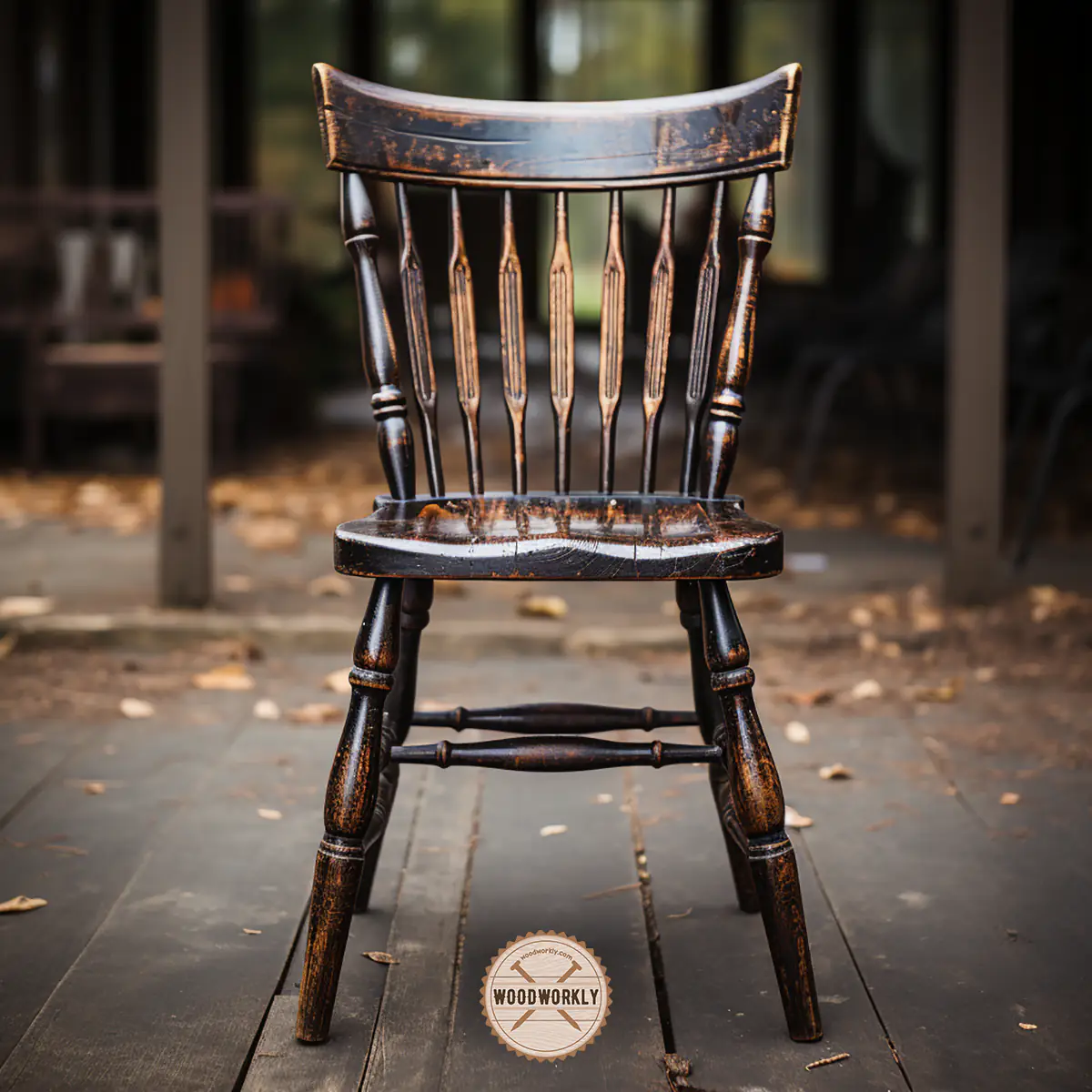
Elmer’s wood glue MAX for Stained Wood
Elmer’s wood glue MAX is the upgraded version of regular Elmer’s wood glue which can only use over bare wood.
Elmer’s wood glue MAX is capable of building strong joints for stained wood and also perfect for outdoor applications due to high weather resistance.
Elmer’s wood glue MAX has the ability to build a strong bond that is stronger than the wood around it.
Therefore you no need to worry about failing the joint due to less strength.
Here I have listed some pros and cons of using Elmer’s wood glue MAX over stained wood.
| Pros | Cons |
| Forms the strong joint | Can only apply over wood |
| Less clamping time | |
| Non-toxic | |
| Weather resistance | |
| Can use for Indoors and Outdoors | |
| No fumes | |
| Able to apply on MDF |
As you can see above wood glues do a pretty good job over stained wood surfaces, not like regular wood glues.
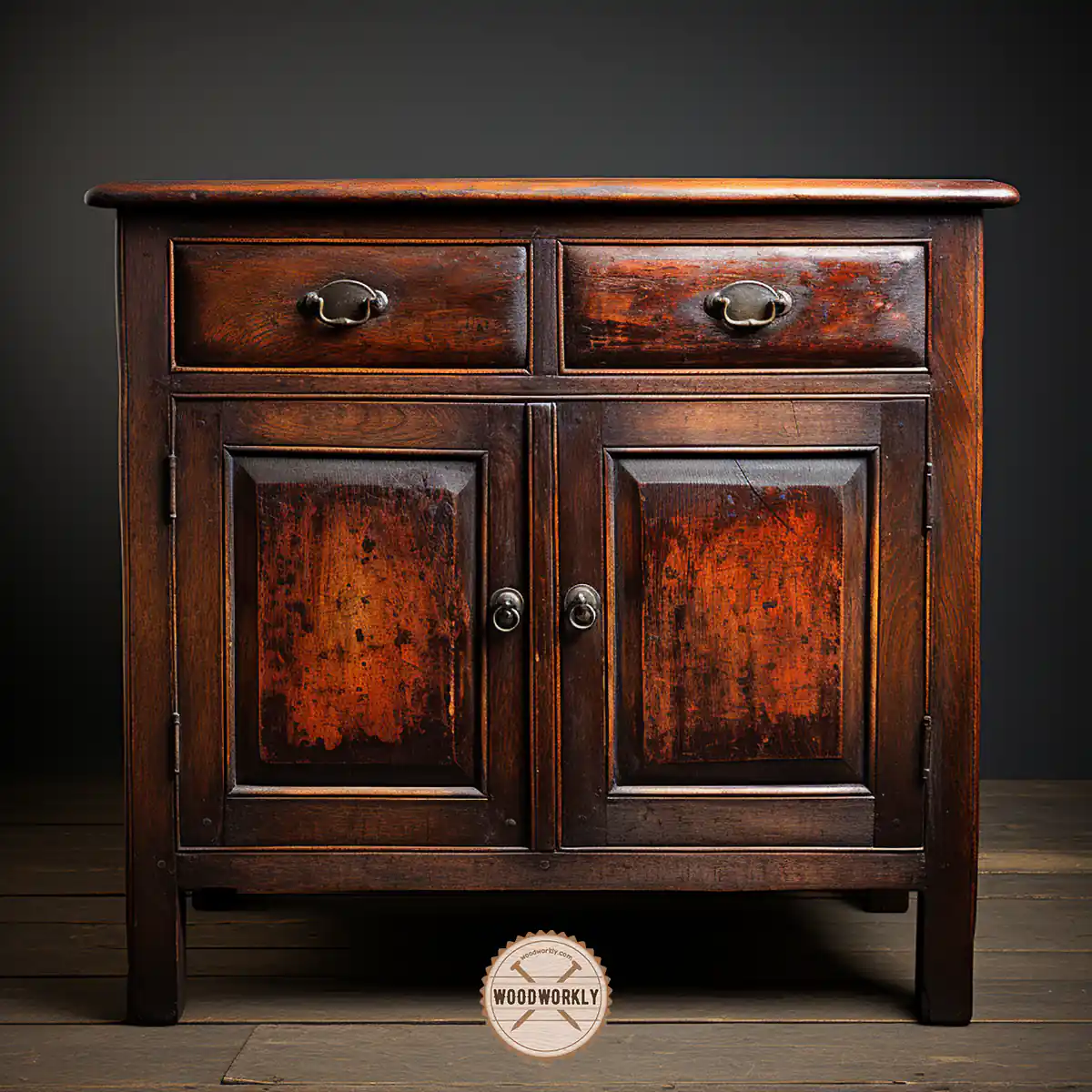
So, let’s talk about the proper method you should follow when applying wood glue over the stained wood surface.
How to use Wood Glue on Stained Wood?
There are several steps you need to follow when applying wood glue over stained wood because it’s quite difficult to build a strong joint within stained wood than the bare wood surfaces.
Tip: Shake the wood glue bottle before using it.
1. Prepare the wood
First of all, you need to make sure the stained wood is clean and dry. Otherwise, residues make the process difficult.
2. Apply Wood Glue
Apply a thin layer of wood glue over both surfaces of the wood. For bare wood applying a thin layer over the single side is ok, but for stained wood, we need to apply wood glue over both surfaces to gain a strong joint.
Use a glue brush to do this task perfectly.
3. Clamp the Surfaces
20–30 minutes of clamping is required after the glue is applied. As in my experience, I recommend camping for at least 30 minutes or more because here we talk about stained wood.
The longer the clamping time makes the bond stronger.
Once the clamping time is done you should be able to see the strong joint between the wood. You can test the strength of the joint by applying extra force to it.
After the day of camping, the bond will get even stronger within the next few days.
So probably at the end of the first week, after the wood gluing is done, you can get the maximum use of your woodwork because the drying is completely done.
4. Clean the Excess when it’s Wet
After the glue is applied and the clamping, you’ll be able to see some extra amount of wood glue will come to the outside between the surfaces.
I highly recommend removing the excess amount of glue before the wood gets dried. Otherwise, you won’t get any chance to remove those after the glue is dried without harming the joint we build.
So, to the wiping off the glue in the first place before drying.
5. Store in a Dark Cool place
After the job is done you can place the woodwork in any place you want. But make sure to store the glue in a cool dark place.
This is done to avoid hitting the sunlight because UV rays can change the chemical structures of the glue and destroy the formula of wood glue.
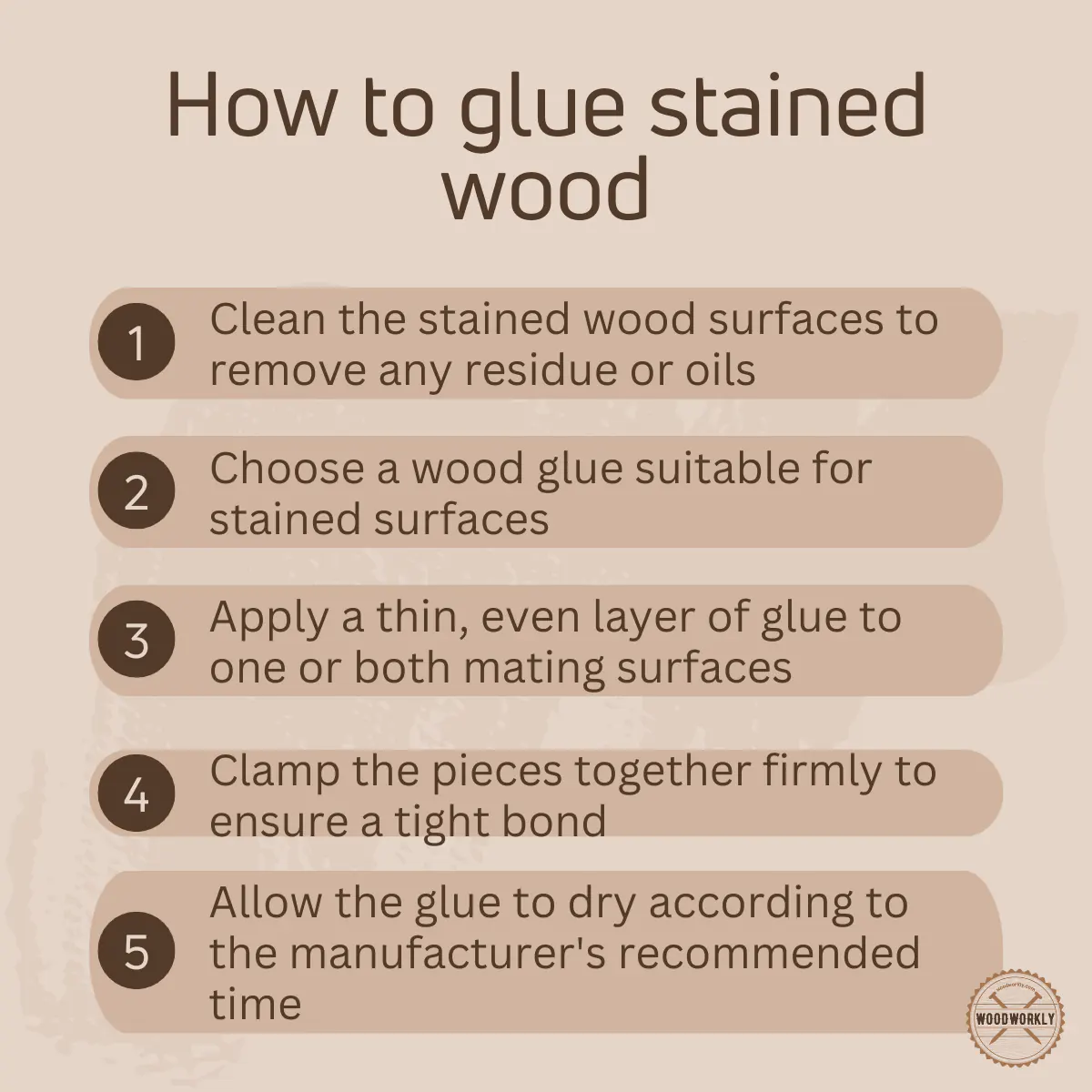
Will Super Glue Work on Stained Wood?
Yes, Superglue works on stained wood. But only if the clamping area is small.
I do not recommend using super glue for large clamping areas because of less strength. Because super glues are not good at gap-filling.
To clamp small areas using super glue, first, clamp the dry wood pieces together and run super glue into the joint.
After that let it dry. This trick will help you to build a strong joint for small, stained wood surfaces.
Read to know how krazy glue work on wood!
Hot Glue on Stained Wood
Hot glue works perfectly on stained wood. The hot melted liquid gel can penetrate through the stained wood surface, not like other wood glues. Because of the penetration, hot glue can build the strong joint we want between the stained wood pieces.
In my experience, Surebonder #825 is the recommended hot glue for stained wood and painted wood.
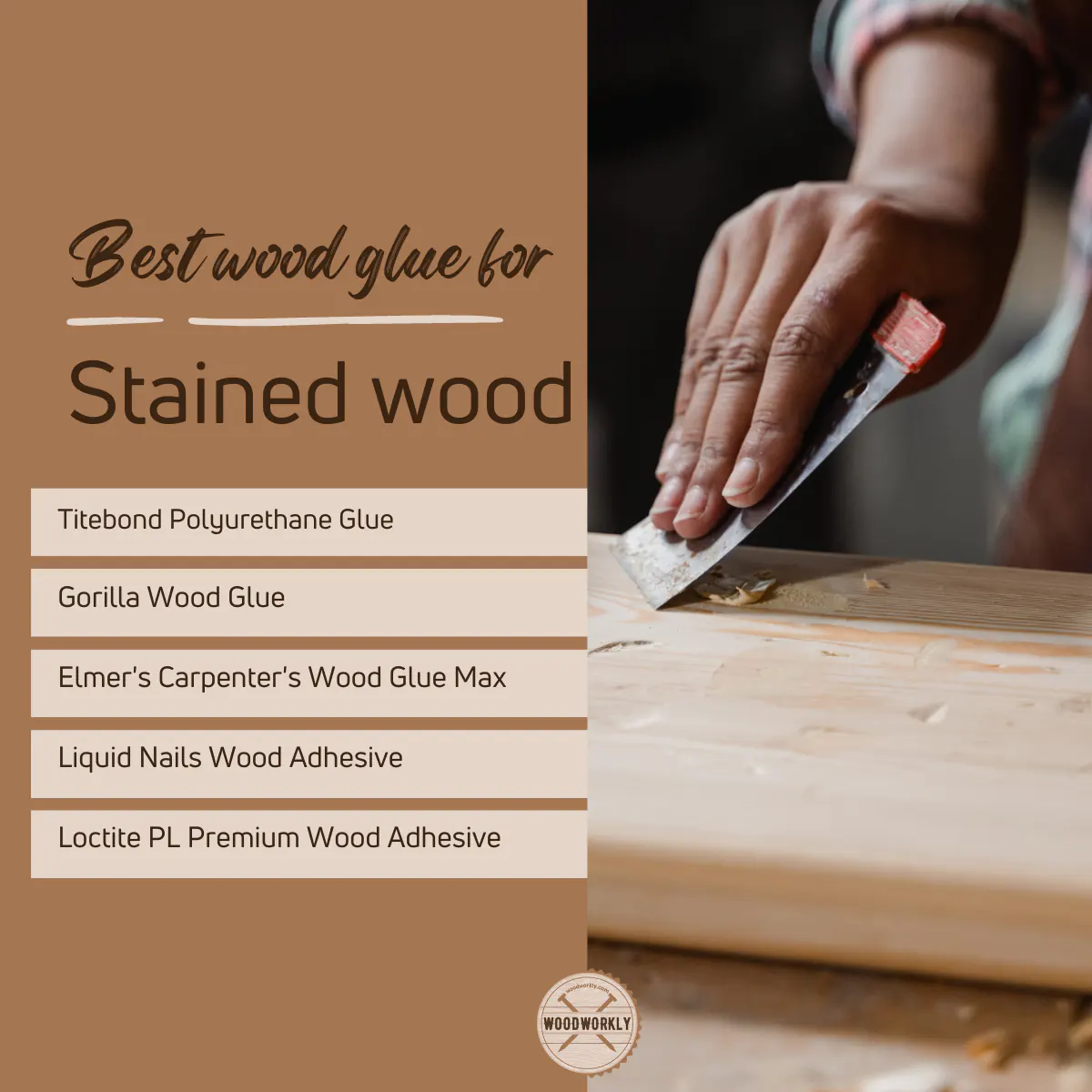
How to Get Wood Glue Off Wood
First of all, don’t panic. While wood glue is designed to create strong bonds, with a few techniques up your sleeve, you can tackle those spills and drips with confidence.
Join me as I share some tried and true methods, peppered with my own mishaps and successes, to help you navigate this sticky situation.
Fresh Spills: Act Fast!
The key to an easy cleanup is speed. Fresh glue is much easier to remove than dried glue.
Here’s what to do:
- Wipe Away Gently: Using a damp (not wet) cloth, gently blot the glue. Avoid rubbing, as this can spread the glue even further.
- Scraping Technique: With a plastic scraper or an old credit card, you can often lift off the excess glue without scratching the wood.
Remember that time when I was making a birdhouse? I got a little too enthusiastic and ended up with glue all over the place.
Trust me, a damp cloth was my best friend that day.
Dealing with Dried Glue: Patience is Key
Once the glue has dried, it’s a bit more challenging, but not impossible.
- Gentle Scraping: Use a scraper or putty knife. Start gently, increasing pressure only if needed. I once made the mistake of being too aggressive and left a scratch that was harder to fix than the glue spot itself!
- Sanding: If the glue is stubborn, sanding might be your solution. Start with a coarse-grit sandpaper and move to a finer grit to smoothen the wood. Just be cautious; you don’t want to remove more wood than glue.
- Warm Water and Cloth: For some glues, especially PVA types, placing a damp cloth over the dried glue and letting it sit for a few hours can soften it. Once soft, it often becomes easier to scrape away.
The Heat Method: A Warm Solution
Using heat is a technique I stumbled upon during one of my “glue disasters”. Here’s how it works:
- Apply Gentle Heat: Using a hairdryer on a low setting, gently warm the area where the glue has dried. This softens the adhesive.
- Scrape Off: Once the glue becomes pliable, use a scraper to gently remove it.
Be cautious and avoid overheating the area as this can damage the wood or its finish.
Commercial Solutions: When All Else Fails
There are commercial products available that are designed to dissolve wood glue.
Always test on a hidden area first and follow the manufacturer’s instructions to a tee.
Final Touches: Restoring the Beauty
Once the glue is removed, you might need to touch up the area, especially if you had to sand or use chemicals.
Re-stain or finish the area as needed to match the rest of your piece.
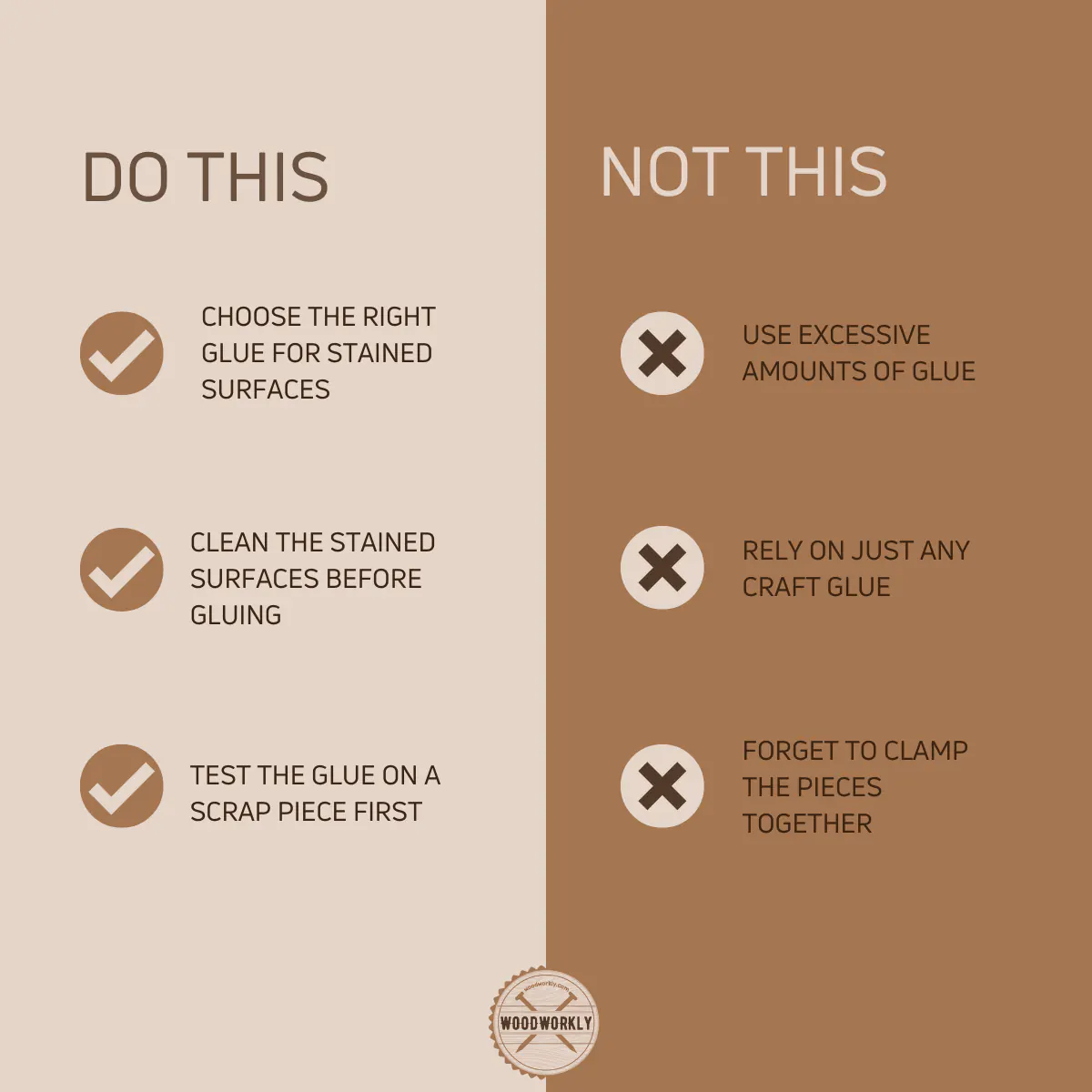
Alternative Methods To Connect Wood Pieces Without Wood Gluing
We’ve all been there, the moments when we realize we’re out of wood glue or perhaps we’re working on a project where glue just isn’t the right choice.
Fear not, fellow woodworkers! There are a plethora of ways to join wood pieces together without reaching for that trusty bottle of adhesive.
Let me walk you through some of my favorites, peppered with memories of past projects and the joys of discovering each technique.
Traditional Joinery: Time-tested Techniques
Some of the most durable and beautiful wooden pieces are held together with traditional joinery techniques.
These methods, handed down through generations, have stood the test of time.
- Dovetail Joints: This is a classic. The interlocking dovetail design not only looks aesthetic but also provides a robust connection. I remember crafting my first dovetail for a drawer. The satisfaction of seeing those pieces fit perfectly was unparalleled.
- Mortise and Tenon: A tenon, or a peg of wood, fits into a corresponding hole, the mortise. When done correctly, it’s an incredibly strong bond. Dining tables and chairs often use this technique for stability.
- Dowel Joints: Using cylindrical pegs, or dowels, to connect pieces of wood is both effective and clean. It’s a method I often resort to when making bookshelves.
Fastening: When Speed is of the Essence
Sometimes, we just need to get things held together quickly.
Fasteners, in these cases, can be a real lifesaver.
- Screws and Nails: The most obvious and common choice, screws and nails can be used in countless ways. Remember to choose the right size and type for your wood and purpose. Pro tip: Countersink your screws and cover them with wooden plugs for a neat finish.
- Staples: For lightweight tasks like attaching back panels to bookcases, a staple gun does wonders.
Modern Connectors: Innovations in Woodworking
Modern problems require modern solutions, and woodworking is no exception.
There are some fantastic connectors in the market that cater to various needs.
- Pocket Hole Joints: These are a personal favorite. Using a special jig, you can drill angled holes into one piece of wood and then screw it into another. I’ve used this for countless frames and cabinets, and the strength is admirable.
- Biscuit Joiners: This involves cutting slots in wood pieces and inserting a ‘biscuit’ which, when clamped together, expands and locks the pieces in place. Ideal for edge-to-edge joints like in tabletops.
- Cam Locks and Nuts: Commonly found in flat-pack furniture, these connectors are user-friendly and require just a screwdriver. Though, I must admit, assembling furniture with these always feels a bit like solving a jigsaw puzzle!
Natural Adhesion: Nature’s Glue
For those looking for natural alternatives, there are a few choices that might surprise you.
- Tree Resin: This natural sticky substance can act as an adhesive in some situations. It has a rustic feel and is biodegradable.
- Pegs and Wedges: Craft wooden pegs or wedges to fit into holes or slits in your pieces. As they’re driven in, they create a tight, secure fit. It’s old-school but effective.
Read to know about the strongest wood joint!
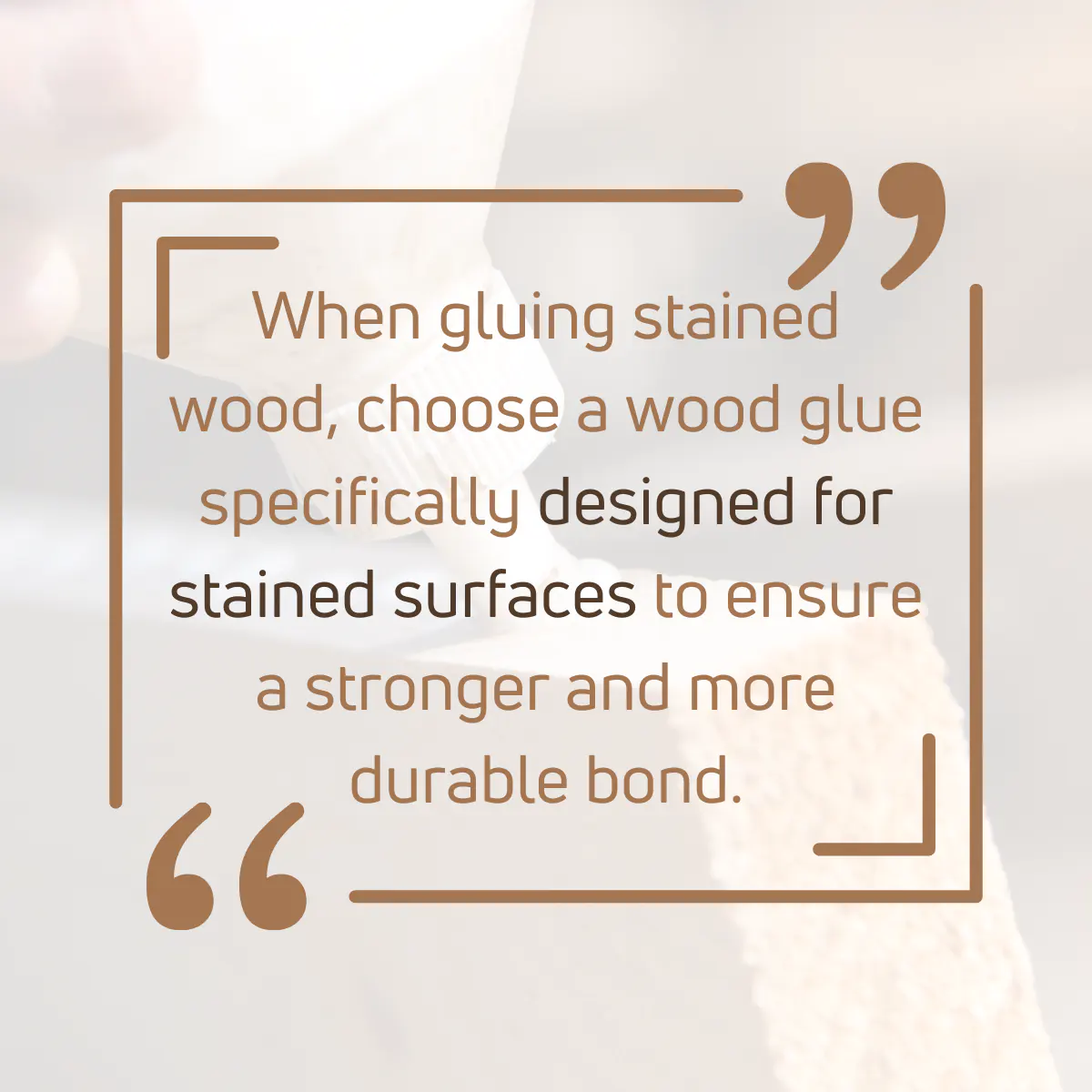
Does Wood Glue Work Well on Bare Woods or Stained Wood?
Both bare and stained woods have their unique characteristics and challenges. While wood glue thrives with bare wood’s open embrace, it might need a bit of coaxing and understanding to bond well with stained surfaces.
Well, fellow woodworking enthusiasts, let’s delve into this fascinating subject and clear the sawdust off some misconceptions.
Adhesion
Before diving into specifics, it’s essential to grasp the basic principle of how wood glue works.
In the simplest terms, wood glue forms a bond by soaking into the wood fibers and, as it dries, it hardens, binding the two surfaces together.
Now, the success of this process depends on how well the glue can penetrate the wood.
Bare Woods: The Natural Connection
Bare wood, in its untouched, virgin state, is like an open book, eagerly awaiting stories (or, in our case, adhesives) to fill its pages.
- Deep Penetration: With no treatments or finishes, wood glue can seep deep into bare wood’s fibers, ensuring a strong bond. It’s like hugging an old friend; the connection is deep and genuine.
- Examples: Picture any handcrafted wooden furniture, like tables or chairs. The joints, often hidden from view, are usually glued when the wood is still bare, before any finish is applied. This ensures the longevity and durability of the piece.
Stained Woods: The Sophisticated Challenge
Stained wood, with its glossy allure, is the sophisticated member of the wood family.
But beneath the charm lies a challenge for our trusty wood glue.
- Surface Barriers: Stains, especially those with sealants, can create a protective layer on the wood. This layer may hinder the glue from penetrating as deeply as it would with bare wood. It’s a bit like trying to converse through a closed window; the connection isn’t as direct.
- Adhesion Varies: Depending on the type of stain and how it’s applied, the success of wood glue can fluctuate. Some stains might leave enough porous surfaces for the glue to adhere, while others might prove more resistant.
- Examples: Think of restorative projects, where you might be attaching a new piece to an older, stained section. Here, it’s often a challenge to achieve the same strength of bond as with bare wood. I recall restoring an old stained cabinet, and the adhesion was indeed trickier. I had to sand the stained surfaces lightly to ensure a better grip for the glue.
Tips for Gluing Stained Woods:
- Sanding Helps: Lightly sanding the stained surface can increase the chances of better adhesion. Just remember to wipe away any residual dust.
- Test First: Especially with heirlooms or valuable pieces, always test the glue on a hidden section to see how well it bonds.
- Consider Epoxy: For particularly challenging surfaces, two-part epoxy might offer a stronger bond than traditional wood glue.
The key lies in understanding the nature of the wood and the stain, and then choosing the right strategy to achieve that perfect, unyielding bond.
Congrats folks! Now you know does wood glue work on stained wood and how to use wood glue properly on stained wood to make the strong bond you are looking for.

So, let’s answer some frequently asked questions.
FAQs
Can I improve the adhesion of wood glue on stained surfaces?
Certainly! Lightly sanding the stained surface before applying glue can enhance its adhesion, but remember to clear away any residual dust.
Will all types of wood glue work on stained wood?
Not necessarily. While many wood glues can bond stained surfaces, some might struggle depending on the stain’s type and application. It’s best to test a small area first.
Does the type of stain affect the adhesive quality of wood glue?
Indeed, it does. Some stains, especially those with sealants, create a protective layer that can hinder the glue’s penetration, making the bond weaker.
I’ve just stained my wood. How long should I wait before gluing?
Wait until your stain has fully dried, which can range from a few hours to a couple of days depending on the product. Always refer to the stain’s label for drying times.
Can wood glue damage or discolor my stained wood?
Generally, wood glue shouldn’t discolor or damage stained wood. However, it’s always a good idea to test a small, hidden section first to ensure compatibility.
What if the wood glue doesn’t adhere well to the stained surface?
If initial bonding fails, consider lightly sanding the stained surface, cleaning it, and then reapplying the glue or opting for a stronger adhesive like epoxy.
Did I cover all you wanted to know about: Does Wood Glue Work on Stained Wood?
In this article, I have deeply discussed Does wood glue work on stained wood and how you should apply wood glue over stained wood with proper guidelines.
Furthermore, The best wood glues available on the market for stained wood with their pros and cons are discussed.
Wood glue work on stained wood. But applying glue on top of the stained surface mostly doesn’t give the strong joint you want. To get the strong joint, wood glue needs to penetrate through pores and wood fiber structure, which doesn’t happen when gluing stained wood.
Apart from using wood glue on stained wood, we have talked about alternative glues such as hot glue and super glue which can also build a strong joint between the stained wood well.
However, in my experience, whatever the wood you’re working on, always make sure to apply wood glue before the staining. Because nothing builds a strong joint than a bare wood-to-wood glue joint.
This is not applicable for some occasions, such as when gluing underlayers and areas we cannot reach.
For those areas, you can do the staining and then apply the wood as I discussed in this article.
Hope this article gave you a proper understating of how you should build a strong joint on stained wood without any issues. So, let’s give it a try!
Hello! I am making a growth chart as a birthday present for a friend’s son. What type of glue would you recommend using to glue the numbers to the stained board? Thanks!
Hi Hannah,
Titebond Polyurethane glue is recommended